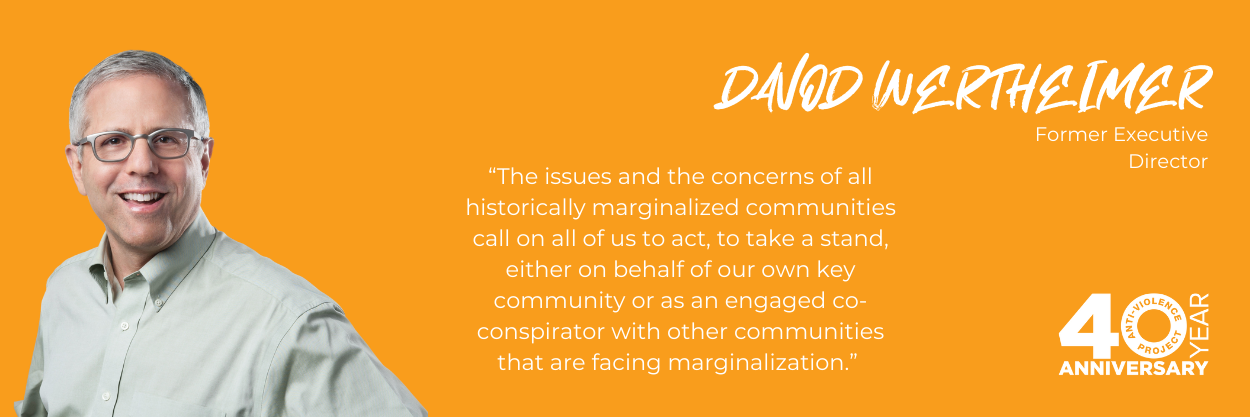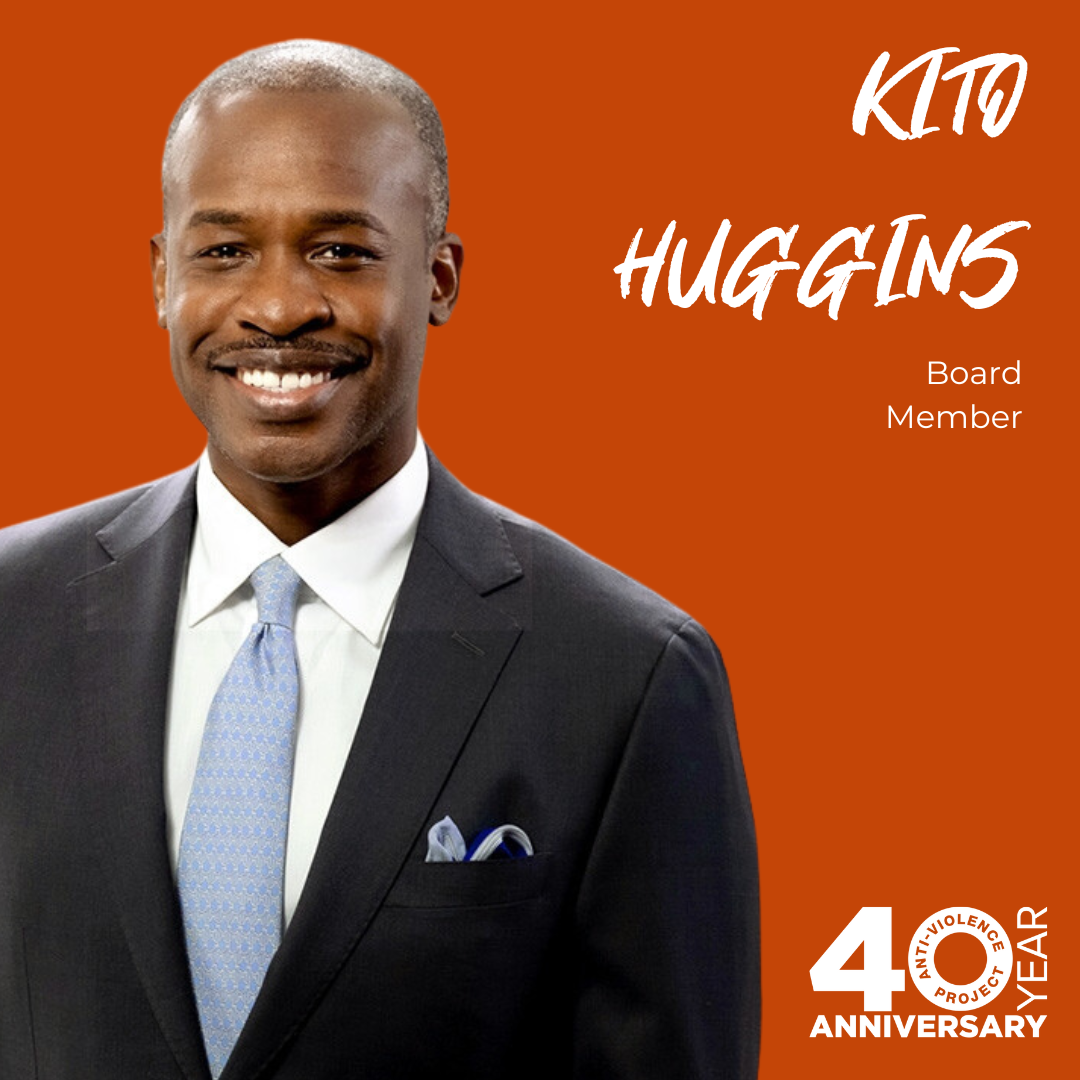
This interview has been shortened and condensed for clarity.
David Wertheimer was the first Executive Director of AVP. Steering AVP during the AIDS crisis and beyond, David took inspiration from his trade union organizer parents. Trying to hold perpetrators accountable for queer-bashing in the eighties was a difficult endeavor at a time when getting recognition in the press was a rare feat. “It was pretty intense because it was also the same time that the AIDS crisis was emerging with a vengeance in New York City. And so, our community was under attack from multiple different venues, from people who hated us, from a virus that was killing us.”
David discussed what kept him going, his thoughts on leadership, AVP’s early response to same-sex domestic violence and homophobic violence, and the relevance these issues still carry today. “The issues and the concerns of all historically marginalized communities call on all of us to act, to take a stand, either on behalf of our own key community or as an engaged co-conspirator with other communities that are facing marginalization.”
How did you first learn about AVP and how did you first get involved?
I am a native New Yorker. I grew up on the lower east side of Manhattan. My parents were both trade union organizers, and they felt it was important to live with the people that they worked with, who were employed in the garment industry. I came back to New York City after graduate school. Grad school for me was a fun and challenging laboratory for being an out, queer activist in the early 1980’s. I really wanted to get involved in the City’s gay and lesbian community, as it was known at the time. And, for a variety of reasons, the Anti-Violence Project really spoke to my interests and passions. First of all, I’m the gay son of a father who fled Nazi Germany in 1933. The issues of doing justice, and confronting violence and genocide, were very much a part of my family experience growing up. And my parents, as I said, were both labor organizers, so they were always about doing the people’s work and being with and for those who they could support to empower their voices. Additionally, during the Vietnam war, I was attracted to Quakers and their non-violent activism. I became a Quaker, and decided that the Anti-Violence Project would be one pathway to embodying my beliefs in my work.
When I started in October of 1985, I rapidly reduced my salary so I could bring AVP’s existing part-time employee to full-time status. Our first office was at the back of a real estate management company on 8th Avenue and 14th Street that was owned by a gay man who invited us to use part of his office for the Anti-Violence Project. I was the Executive Director from October 1985 to December 1989. By the time I left AVP, we had relocated our offices to the newly opened Lesbian & Gay Community Center on 13th Street.
What was your inspiration for getting involved with AVP?
Well, there weren’t very many organizations or people doing anti-violence work in the gay community back in those days. In 1985, when I started, there were only two groups in the country: the Anti-Violence Project in New York and Communities United Against Violence (CUAV) in San Francisco, led by Diana Christensen, who was an amazing voice for our issues. Also, about the time I started, the National Gay and Lesbian Task Force launched an anti-violence program that was managed by Kevin Berrill, who was essential to creating a national platform for raising our issues.
Defining these issues was challenging but essential work. Back in the 1980’s queer bashing was still considered by many as a legitimate “sport” – groups of young men would go out on the weekends into our community, search for lesbians, gay men, and transgender people, and beat us up, simply for being out and visible as our true selves. They rarely faced any consequences for their actions.
In these early days, although some in police leadership acknowledged the existence of anti-gay violence, police at the rank-and-file level fairly consistently ignored, or even joked about, the violence our community was facing, and failed to respond when our community was under attack. AVP and our allies worked together to raise awareness of the issues and define them by saying, “These attacks against us are wrong. The violence against our community must be confronted and named for the evil that it is. Once named, the systems that are accountable for justice need to take it on and address the harm it is doing to our communities.”
What was it like during those early years at AVP?
It was an intense time, because it was also the same time that the AIDS crisis was emerging with a vengeance in New York City. Our community was under attack on two different fronts: from people who hated us and from a virus that was infecting and decimating our community. There was also a fairly consistent lack of interest and engagement from the systems that were, that should have been accountable for our safety and wellbeing: The public health system and the criminal justice system.
I should also note that we did have a few champions in the justice system during that time. In the Brooklyn District Attorney’s Office was a young assistant district attorney who took a great interest in these cases when they took place in Brooklyn, and prosecuted them with a vengeance. His name was Evan Wolfson, who eventually became one of the architects for marriage equality. Evan was an early pioneer at the systems level, working on anti-violence issues.
At the time, AVP maintained the 24 hour hotline that the Chelsea community started long before I was involved with the Anti-Violence Project. We took that hotline and built it into a 24-hour service with volunteers who could field and respond to the calls we received. Our volunteers would carry a little pager, which would beep if the answering service got a call. You’d call the answering service and they would give you the number of the person in crisis to call. It was a very primitive technology back then, but it worked. AVP was able to provide a response to people who’d been victimized, and then use those stories and that data to confront and challenge the systems that were, or should have been, accountable for our safety to take more action related to anti-gay violence.
We also started one of the very first same-sex domestic violence programs in the country. That issue had never been addressed openly to promote safety within our community for people who were in abusive relationships. Starting that program was, in and of itself, controversial, because many people within the community said, “Why are you raising this issue?”, or, “Our relationships are criticized enough by the mainstream community. Let’s not talk about this.” AVP’s response was simple but assertive, “No, that’s exactly the reason we have to talk about this. We need to work together to ensure safety within our own relationships.”
About that time, we also started the first male sexual assault program in New York State. We had been receiving fairly regular calls from men who had experienced a sexual assault, and so we decided to apply for funds the state had made available through a request for proposals. I was truly surprised when we got the grant, and that we were the only recipient of funds anywhere in the state. I called the person who was administering the grant and asked her why we had been selected. Her response was simple, but also highlighted the under-reported nature of these crimes: “Well David,” she said, “you’re the only organization that applied.”
In addition to domestic violence and sexual assault, by the time I left we also needed to launch an AIDS-related violence program because so many gay men were being targeted because of public reactions to the AIDS epidemic. Our experience in the 1980’s is strikingly similar to the way today people in the Asian American community are being targeted because of misperceptions and incorrect information about COVID.
Do you have a favorite memory of your time at AVP?
That’s a great question. What stands out for me from this whole period of time was the bravery of the survivors of these attacks who agreed to come forward and tell their stories. Many of them had severe physical injuries. There were, of course also, murders of queer people whose stories had to be told for them. Those survivors who came forward to tell their stories were amazing, despite the humiliation they often experienced from their families, their neighbors, and even from some in our own community, who didn’t want us talking about these issues. Their bravery is what stands out to me the most – their willingness to tell their stories honestly, bring visibility, and shine a light on an issue that too many people didn’t want any of us to be talking about.
How did your time at AVP influence your future work?
I think that period of time in my life, as well as my upbringing from my parents and their work in the trade union movement, really demonstrated for me that the issues and the concerns of all historically marginalized communities call on all of us to act, to take a stand, either on behalf of our own communities or as an engaged co-conspirator with other communities that are facing marginalization. And, I also recognized, I think at the Anti-Violence Project for the first time, that there are, from my perspective, three kinds of leadership: one is being a leader out front and naming the issues and calling them out, and calling people to action. The second type is locked arm and arm with others moving forward in a way that creates an insurmountable response to a challenge of systemic oppression and marginalization. And then, the third is leading from behind, and supporting those who are out in front with whatever capacities you have to be supportive of those individuals who are putting themselves out there on the line and taking enormous risks. I think all three forms of leadership are essential in support of the concerns and the liberation of marginalized communities that need both strength from within their ranks, but also co-conspirators who support their efforts to make change happen. That’s what the Anti-Violence Project was all about, working both within our community to acknowledge and name the issue, as well as challenging those beyond our community by asking, “What are you going to do about this? This is a really serious problem.”




